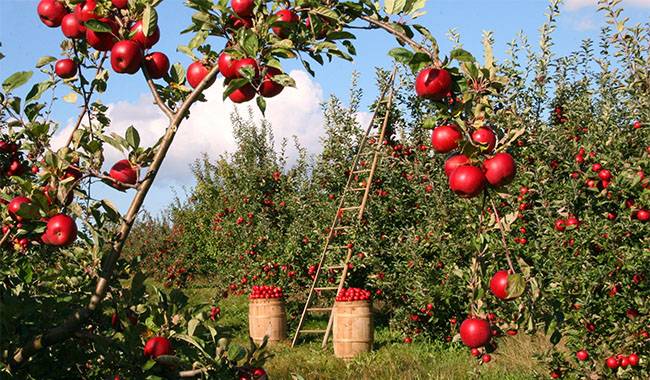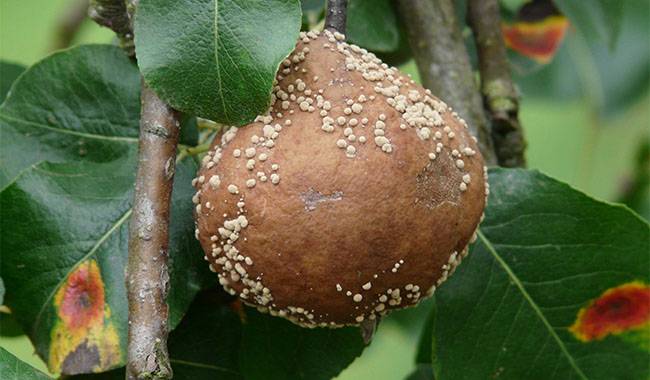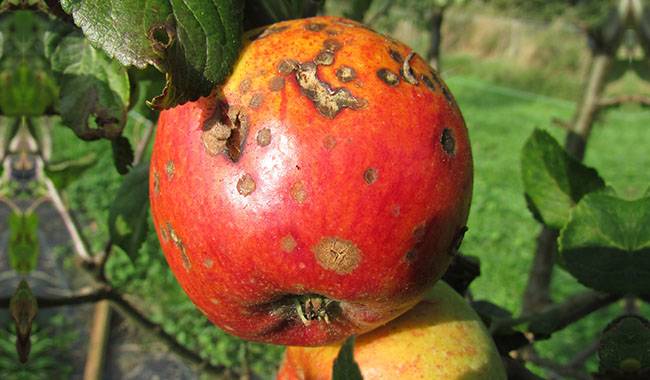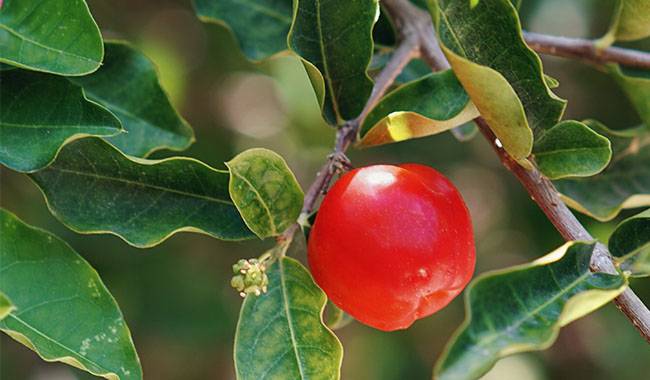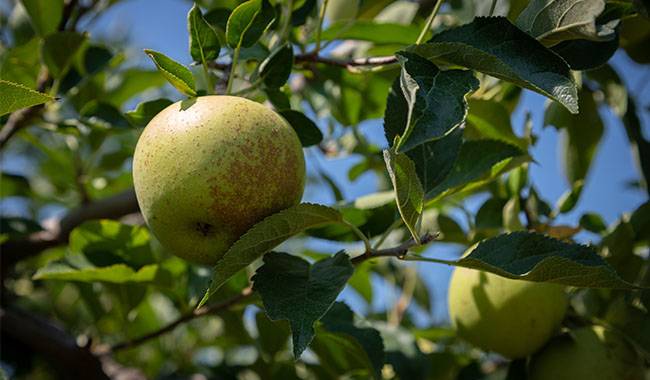
We planted our own apple orchard, pre-selected our favorite apple tree varieties, bought saplings, and planted them in pre-selected places.
How to take the apple tree care? What more work do we need to do and make our orchard pleasing in the eye?
Recommend you to read “Apples: 5 Health Benefits shows apples good for you“
The young orchard needs more care and maintenance because only by giving things away we can expect a good harvest.
The correct maintenance of apple trees will let you taste delicious and healthy fruits throughout the winter.
Only with proper maintenance, the apple orchard will become our pride and the main decoration of the family community.
How to properly plant an apple tree care – this article will teach you.
Apple tree maintenance requires more nutrition
An apple tree needs to increase its nutrition several times a year. For young trees, fertilization is particularly important.
But for young trees, be very careful when applying fertilizer. Fertilization (especially nitrogen fertilizer) should be diluted with a lot of water.
Fertilization in spring
Spring is the time of life. It is at this time that apples desperately need fertilizer to bloom. Consider the soil in the gardening area when choosing fertilizers.
Adding nitrogen to sandy soil is useful, but black soil does not require nitrogen.
Soil moisture plays a big role in spring fertilization:
NOTE:
Large amounts of fertilizer can be used for good watering of trees. They are dry in humid and humid weather. Just spread the fertilizer around the tree, and with the rain, the top dressing will achieve the desired purpose.
In the maintenance of apple trees, foliage feeding (canopy spray) is also required. This procedure should be carried out in the early morning or evening (as long as there is no sun in the weather).
If the weather is cold, you can also spray the canopy in the afternoon. When applying foliage fertilizer, the fertilizer should be diluted, otherwise, the leaves will be burnt.
The first leaf
In spring, when the first leaves appear, start fertilizing. At this time, apple trees need to use nitrogen additives for root fertilization.
The additive is smeared around the crown of the tree after digging. You can choose one of the following fertilizers (for each apple tree).
Phosphorus nitrate and ammonium nitrate: 30-40 grams;
Urea: 500-600 grams.
Fertilizer: 4-5 bottles.
Blossom
During flowering, apple trees also need food. At this time, it is best to make liquid fertilizer (if it is dry weather).
You can choose one of the following variations (4 bottles of compounds per tree). All fertilizers below should be diluted in 10 liters of water.
Potassium sulfate: 60-70 grams, super phosphoric acid: 100 grams.
Mud: 0.5 buckets.
Chicken manure: 1.5-2 liters.
Urea: 250-300 grams.
Bear a crop
The third fertilization is after the apple tree blooms (full and mature period). Choose one of the methods.
Sodium Humate: 10 grams
Nitrophosphorus card: 0.5 kg per 100 liters of water (2-3 barrels per tree).
Green manure (diluted with 1:10 water). Place the green parts of the grass in a large container and cover them with water.
Cover the container with pre-perforated polyethylene. After 20-25 days, green nutritional supplements can be prepared.
Summer fertilization
In summer, trees need not only nitrogen supplements but also fertilizers rich in phosphorus and potassium. In the hot season, feed the apples many times. The minimum interval of summer fertilization: 10-14 days.
In June
The first summer fertilizer was carried out in mid-June. Fertilize the leaves.
If the month is rainy, apply on the roots. Urea should be diluted with water in the specified proportion.
The older the tree, the higher the concentration of urea. When spraying, urea should also be used to treat the trunk, which can kill pests on the apple tree.
In July
In July, it is best to feed potassium and phosphorus to apple trees. During this hot period, spray fertilization on the canopy.
Distribute this ingredient evenly on the entire leaf surface. Trees also need nitrogen feed. Pause for 1-2 weeks between mineral and nitrogen feed.
Fertilization in autumn
Apple trees no longer need foliar feeding, otherwise, the tree has no time to prepare for hibernation.
But apple trees need potassium and phosphorus additives:
- You can buy a ready-made composition according to the instructions, dilute with water, and apply it to the crown area.
- You can prepare by yourself: potassium (1 tablespoon L), double superphosphate particles (2 tablespoon L) for every 10 liters of water. Pour the composition into the garden every 1 square meter. m. 10 liters of solution.
Topdressing is not difficult, but a separate method is required. Planting apple trees is an important tip for novice gardeners:
- When caring for dwarf apple trees, reduce fertilizer usage by 25-30%.
- In order to make the plant better absorb liquid fertilizer, please apply it in 30 cm deep holes. Dig these holes on the entire circumference near the circumference of the shank.
- However, do not make such holes when fertilizing cylindrical apple trees (their root system is too close to the soil surface, so the root system may be damaged).
For these types of apple trees, it is best to spread fertilizer under the trunk or water directly around the roots.
If an apple tree lacks any elements, it will immediately notify the owner by changing its appearance.
| Missing element | Apple tree’s response |
| Nitrogen | The leaves began to become thin and pale. |
| Boron | The leaves curl and shrink, and the veins turn yellow. |
| Iron | The leaves turn yellow and lose their color, the edges of the leaves begin to wither, and the young shoots are stunted. |
| Potassium | The leaves turned dull greenish-blue with drooping edges. |
| Calcium | The leaves begin to turn white, curl upwards, and then fall off. |
| Magnesium | The leaves become red, yellow, or purple (they remain green along the edges and veins). |
| Copper | Although the apple tree is well taken care of, its leaves will turn pale and show brown spots. Then they became lifeless and mottled. |
| Phosphorus | The crown of the tree became dull, with bronze in the dark green. Sometimes a purple or red color appears on the leaves. |
| Zinc | The leaves become very small, wrinkled, and narrow, obtaining a mottled pattern. |
Water that gives life
Timely watering is very important for apple trees. Don’t start watering as long as you have water on hand, it’s wrong.
For the normal development of trees, water three times (provided that the soil water saturation reaches a depth of 80 cm).
- The first watering: in the flowering period (early summer).
- Second watering: early July (the time when the fruit ripens quickly).
- The third watering: October, before the frost is expected.
In areas with arid climate conditions, it is best to increase the frequency of watering.
The ideal temperature for apple trees is 65°F-80°F.
Experienced growers, when maintaining apple trees, recommend calculating the appropriate amount of water-based on the age of the tree (how old is the tree and how many buckets of water are needed).
According to accepted standards, trees aged 1-2 years need to be watered 4-5 buckets, and mature fruit trees need 7-10 buckets per square meter of the root zone.
Young trees need more water because they are growing. Water 4-5 times per season.
Trees should be watered directly under the root neck. In this way, the water will penetrate to the roots faster.
Well, water is better for apple trees less than 3 years old. Old trees can be ditched to add water (ditching to make the depth 50-60 cm).
After 2-3 days after watering, loosen the soil and cover it (you can use peat, humus, sand, or sawdust).
If you use a hose for watering, make sure that the water pressure is around the plant crown.
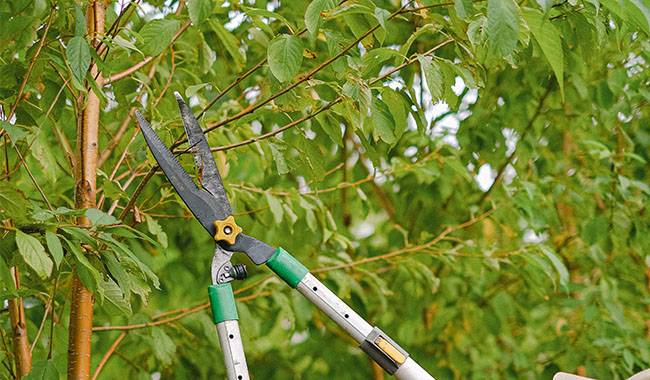
Recommend you to read “Different phase for apple tree life cycle and features“
Pruning and maintenance of apple trees
Apple trees need sunlight to get a good harvest. To ensure that the trees can get the necessary light, the apple trees must be pruned.
The operation is performed at different times of the year:
Spring
In March-April (before the leaves open), pruning the tree in order to shape the crown.
At this time, the apple tree has the strongest regenerative capacity (the rich sap has not yet begun to flow, so the wound will heal better and faster).
Summer
During this period, the apple tree has a lot of young shoots-it needs to be thinned out, and the remaining young shoots need to be diluted.
According to experts’ recommendations, only the competing branches on the main branch and the scion along the backbone of the main branch should be removed in summer.
Autumn
Prune apple trees in autumn to prepare for winter. At this time, the trees need to be separated from unsold branches, too large branches, and dry branches.
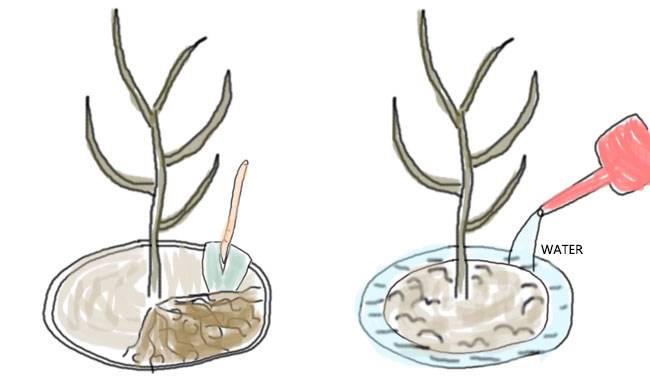
Crown formation
There are several different ways to shape an apple tree. All the proposed methods have one goal: to ensure the correct balance between the main (central) conductor of the tree and the branches derived from it.
Options for crown formation:
Each layer is scattered
The easiest and most popular way to maintain apple trees. This method of formation can increase the yield of the tree while keeping its appearance as natural as possible.
- In spring, measure the area of the seedling 50 cm above the ground. Above this area, we measure another 30 cm area-this area (stem) is used for the first stage of the apple tree. The first sequence includes three main buds.
- After 10 months, buds will grow in the stems. They need to be cut off. In the first row, leave 30 cm long branches, and then leave 2 new shoots at a distance of 20 cm. All branches will be in the same position.
- Next season, we will place the next row 45 cm behind the previous area.
The formation is complete. Now it is necessary to prune the growing main branches above a single branch in time.
The total growth of such an apple tree should not exceed two meters.
Around the crown
This is a quick method (the branches should be handled in small amounts when maintaining apple trees). Completely formed within 3 years.
The apple trees begin to bear fruit in the second season. The design is a basic bud, from which the center bud diverges in different directions.
- In the first year after the apple tree is born, pruning the apple tree, leaving some small stems.
- When the first bud germinates at the butt joint, create a second line and offset the central branch on a different side.
- Cut again in the second year.
- The formation is completed in the third year after the method.
During this period, the apple tree will grow to three meters. After that, shorten the branches on non-vertical buds in time.
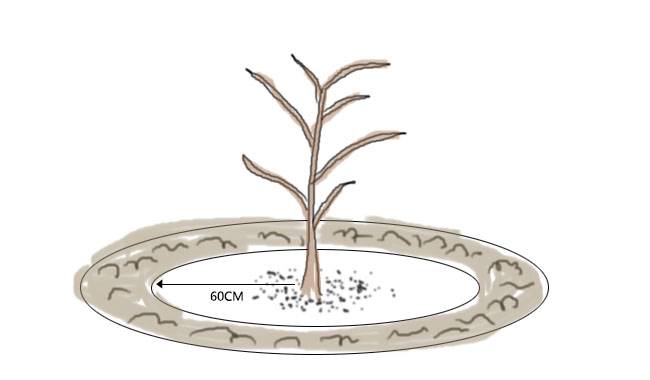
Disc Crown
This technique is more suitable for poorly growing trees. This method is slightly similar to the length method but has its own characteristics.
- In the first row, the three branches are distributed in different directions, so the set angle is about 130º.
- Cut off the main branch 45 cm from the trunk. It is shortened on the central shoot. We need to extract two sprouts from each of the three branches.
The same procedure will be carried out in the maintenance of the apple trees in the next season. The trees will become stronger and stronger. Its immunity will also improve.
Vertical
This method of formation is suitable for apple trees to grow around the garden and form a natural fence. This method takes 4 years.
In this method, the branches from the central trunk are turned into a plane, lying on a horizontal line.
- All branches on the trunk are cut off in each row, leaving only a few branches growing in different directions.
- The vertical shape of all floors should be symmetrical within 80-90cm.
- All buds appearing on the main bud are curved. Apple will mature in the future.
- If the main branch is significantly off the central part, it should be pulled up, and then the branch (with insufficient slope) should be pulled back.
Using this method, the height of the tree can be adjusted by cutting down the trunk and base buds every year. In width, apple trees can grow 2-3 meters.
Vigor Pruning
With this method, when you look after the apple tree, you can endlessly receive delicious fruits from it. To do this, you need to open the center of the tree as much as possible and make the remaining branches sparse.
First, the central trunk is shortened by 1/3, and then the thickened area becomes thinner. The cutting angle must be at least 45º.
It is best to perform this step in the spring when the tree is dormant and without leaves.
Harvest time
In order to preserve our mature apples for a long time (the fruits of autumn varieties can be stored until April), we must be very careful when picking the fruits from the trees (wear cotton gloves when working to avoid damage to the fragile skin).
Ripe fruits lying on the ground should not be stored and can be used for further processing.
Remove the stem of the apple so that it can be stored for a long time. The apple will have a natural waxy coating-no need to wipe it off, it can protect the apple from drying and various microorganisms, and help the management of the fruit.
Collect fruits when the weather is dry, preferably in the afternoon.
Summer varieties of apples
They were harvested in August. Their storage time is not long.
But they can be harvested 2-3 weeks before they are fully mature and stored at around 30°F-40°F.
It can then be stored for about 3 to 4 weeks.
Autumn varieties of apples
Apples are harvested at the end of August and early September. At this time they are not fully mature and are a bit sour.
They need to be stored for 2-3 weeks before they are fully mature. If stored well, the taste of autumn apples will be good for about 3-4 months.
Winter varieties of apples
They were harvested in October. The freshly harvested apples have a slightly stiff flesh and a sour taste.
Their maturity period can be as long as 2-3 months. But they will be stored for a long time until April.
How to store apples correctly
Freshly picked apples should be cooled to +40°F and stored immediately.
Generally speaking, apples are stored in boxes made of wood. But such a container has a disadvantage-the wood will rot.
You can also use plastic containers (pre-cleaned and disinfected).
In order to improve the preservation effect of apples, sawdust from deciduous tree species is mixed in the container.
It is best not to use wooden boxes of conifers, as they will impart the characteristic tar flavor of the fruit.
Don’t put the straw and the apple together, it will mold soon.
The moisture content of wood chips should not exceed 15-20%.
It is also useful to cover the apple fruit with maple or oak leaves, peat chips, and dried moss. These plant ingredients have antibacterial effects.
In advance, apples are sorted according to variety, ripeness and size. The larger apples mature the fastest.
Choose a container with only a small gap between the apple and the fruit to be stored.
- Before putting the apple there, treat the container with a bleach lime solution and dry it thoroughly.
- At the bottom of the box, but enough clean paper and sawdust to cover the first layer of fruit.
- Stack your apples. It is best to isolate each fruit by wrapping them in paper. The last layer of fruit is covered with paper leaves and covered with sawdust.
- Seal the container well.
In order to isolate the number of layers of apples, you can use cardboard or synthetic mats to separate them. This helps prevent the spread of diseases in stored fruits and protects the fruits during transportation.
Through the above content, we have learned the basic rules of apple maintenance, but mechanical maintenance alone is not enough to take care of our garden.
It is also important to love it and be grateful for the beauty and happiness it brings us!
And our garden will gladly use its crown to shield us from the sun in the sultry summer and please us with the beauty of its flowers in spring, and of course, it will also present us with a good harvest of high-quality apples in autumn.
I wish you good luck and a good harvest so that your garden will never cause disease and pests will not bother you. But still, we will discuss possible diseases and pests in our apple orchard in a future article.
I also recommend watching a video about apple tree maintenance.




